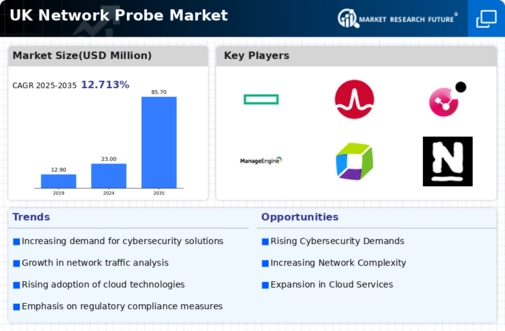Rising Network Complexity
The increasing complexity of network infrastructures in the UK is a primary driver for the network probe market. As organizations expand their digital operations, they often deploy a multitude of devices and applications, leading to intricate network environments. This complexity necessitates advanced monitoring solutions to ensure optimal performance and security. According to recent data, the number of connected devices in the UK is projected to reach 50 billion by 2025, which underscores the need for effective network management tools. Consequently, the demand for network probes, which provide visibility and insights into network traffic, is likely to grow significantly. Organizations are increasingly recognizing that without proper monitoring, they risk performance bottlenecks and security vulnerabilities, thereby propelling the network probe market forward.
Regulatory Compliance Requirements
In the UK, stringent regulatory frameworks are compelling organizations to adopt robust monitoring solutions, thereby driving the network probe market. Regulations such as the General Data Protection Regulation (GDPR) and the Network and Information Systems (NIS) Directive impose strict requirements on data protection and network security. Companies must ensure compliance to avoid hefty fines, which can reach up to £17 million or 4% of annual global turnover, whichever is higher. This regulatory landscape creates a pressing need for network probes that can provide detailed insights into data flows and potential breaches. As organizations strive to meet compliance standards, the network probe market is expected to experience substantial growth, as these tools are essential for maintaining the integrity and security of sensitive information.
Shift Towards Cloud-Based Solutions
The transition to cloud-based services in the UK is significantly influencing the network probe market. As businesses increasingly migrate their operations to the cloud, they require effective monitoring tools to manage and secure their cloud environments. This shift is evidenced by a report indicating that 85% of UK businesses are expected to adopt cloud services by 2025. Network probes play a crucial role in this context, as they enable organizations to monitor traffic between on-premises and cloud environments, ensuring seamless performance and security. The demand for visibility into cloud traffic is likely to drive the adoption of network probes, as organizations seek to mitigate risks associated with cloud computing, such as data breaches and service outages.
Increased Investment in IT Infrastructure
The ongoing investment in IT infrastructure across various sectors in the UK is driving the network probe market. Organizations are recognizing the importance of robust IT systems to support their operations and enhance service delivery. According to recent statistics, UK businesses are projected to spend over £100 billion on IT infrastructure by 2025. This investment encompasses not only hardware and software but also advanced monitoring solutions like network probes. As companies upgrade their IT infrastructure, the demand for network probes is likely to rise, as these tools are essential for ensuring the reliability and security of network operations. This trend indicates a growing recognition of the value of proactive network management in achieving business objectives.
Growing Demand for Network Performance Optimization
The need for enhanced network performance is a significant driver for the network probe market in the UK. As businesses increasingly rely on digital services, any disruption in network performance can lead to substantial financial losses. A study indicates that downtime can cost UK businesses an average of £16,000 per hour. Consequently, organizations are investing in network probes to gain real-time insights into their network performance, identify bottlenecks, and optimize resource allocation. This focus on performance optimization is likely to propel the network probe market, as companies seek to ensure uninterrupted service delivery and maintain competitive advantage in a rapidly evolving digital landscape.

















Leave a Comment